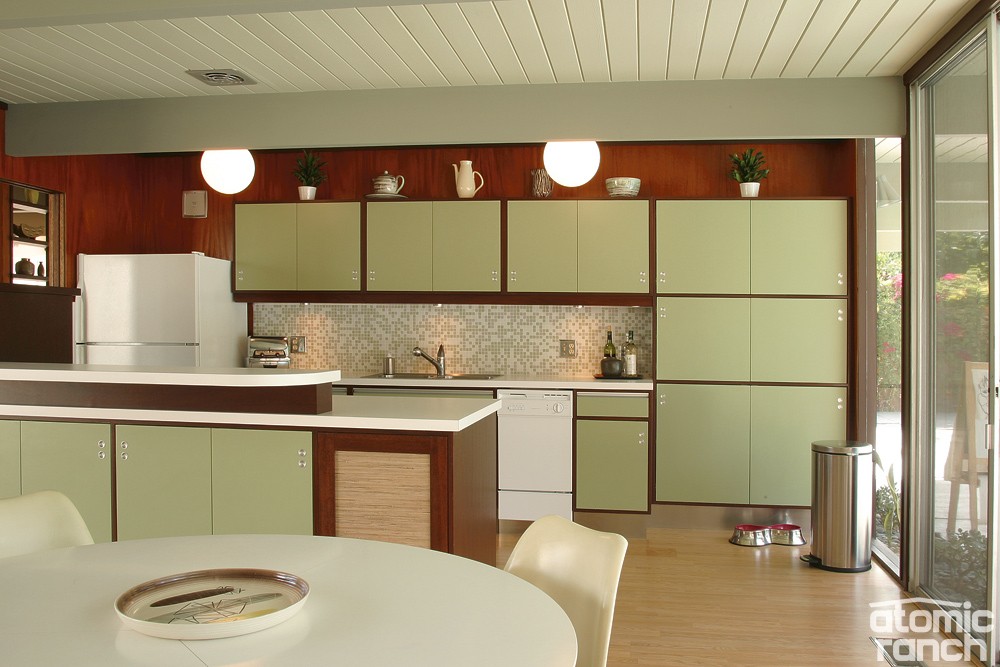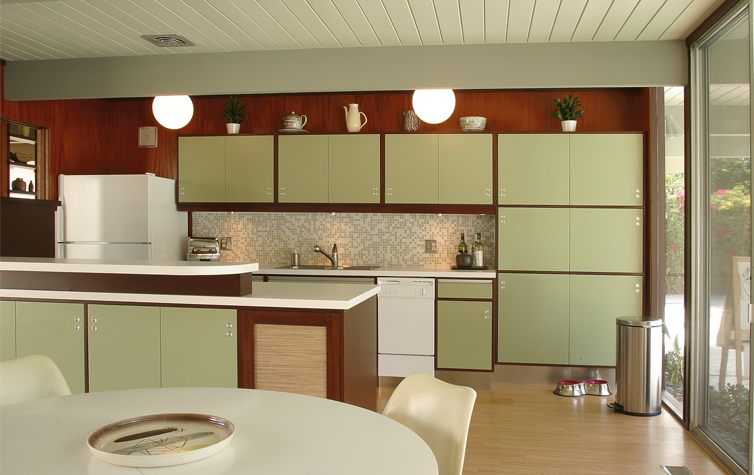
The Jarrett’s had embarked on a restoration of epic proportions (part 1) and were nearing the end of the painstaking venture (part 2). The Eichler kitchen and dining room were the last leg in their marathon reno.
The original kitchen of the home had been replaced with a home-improvement-center special—raised-panel oak cabinets, brass pulls, faux red brick vinyl floor. They recycled the existing cupboards to buyers who thought the style was just grand and gutted the room entirely. Inspiration for their new galley kitchen was based on the prototypical steel Eichler kitchen and their Anshen and Allen blueprints, which gave dimensions, appliance locations and countertop heights.
“Getting the kitchen back was really pivotal to the feel of the house,” Jon says. “The kitchen is the epicenter—it’s where a lot of social activity takes place. I wanted Formica countertops and cabinets, that whole midcentury look.
The couple drew up plans and found a great cabinet guy, Joe Estrada, to help them realize their ’60s pipe dream of an Eichler kitchen. Trouble was, Joe was so popular that their installation was delayed by two months, giving them classic dishwashing-in-the-bathroom, microwaving-in-the-dining-room experiences. The Jarretts selected affordable Frigidaire appliances, including a cooktop with coils instead of the hidden heating elements, which complemented the vintage look of the countertops; an 18” Frigidaire dishwasher was just the right size for the space next to the pantry.
Jon machined the round cabinet finger hole pulls slightly larger than the standard ones you can buy, because “they have more pop,” and the toe kick is edged in a matching aluminum-look veneer. The pulls are sort of a visual joke, as the cabinet doors don’t actually slide but spring open to the touch on hidden hinges. The side of the peninsula that faces the multipurpose room mixes Formica with grass cloth inserts for visual interest.
“The X-100 kitchen is very similar to ours except we don’t have the table,” Gayle says of the low, pivoting breakfast table at the end of the cooktop peninsula in some Eichlers. “Jon designed both a metal-top and a Formica-top table in our plans, but at the last minute we didn’t put it on because we felt it would close off the kitchen too much.” A Saarinen tulip table and chairs in the open multipurpose room is where the family eats, although a dining room space is nearby. They’re hoping for a family heirloom dining set to make its way to them in the foreseeable future.
In that future dining room, the Jarretts opened up the wall with a clerestory treatment of display niches that allow the living and dining spaces to share light and keep the dining side from being claustrophobic. Despite having a full wall of glass, the dining room is relatively narrow and has doors to the garage, water heater and living room on two of the other walls, a design flaw that Gayle found out made their Eichler model less popular initially.
Jon has applied his talents to re-creating Eichler-specific parts for his home, including sheets of the Thin-line siding for a new fence and a missing front-door escutcheon machined out of 3/4” solid aluminum billet whose dimensions he took off of a neighbor’s door.
Speaking of the neighbors, that has been another big plus for the Jarretts. “I can’t say enough about the people who live in this neighborhood,” Gayle says. “It draws creative people, people who yearn for what we remember growing up: kids out playing, people out talking to each other, knowing your neighbor.
“The whole aura of the homes is that Joseph Eichler was a man who had sort of had a wild thought for his time. Even the older people who live in these homes are very creative. For a family like us, this is the best housing choice we could have made. From the neighborhood and the neighbors to the actual layout and design of the home, to have room for Ivy and animals to run around and still be able to see them, it’s been the best.”












